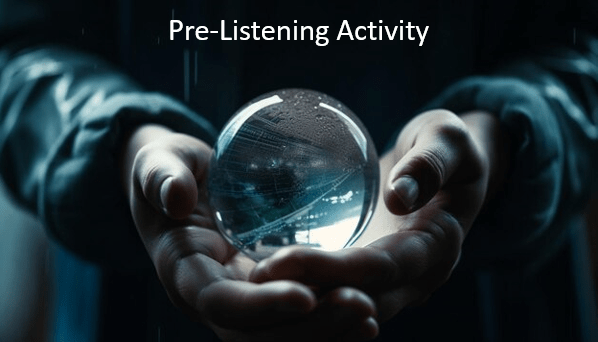
It mat come as a surprise to any number of teachers to realize that most students do not view their ESL class as the number one preoccupation in their lives. Students come into the class with a myriad number of matters on their minds: weekend plans, family problems, the test in the next class. To foster a classroom atmosphere conducive to students’ leaving behind their outside world and to their focusing attention on the lesson at hand (not to speak of their becoming personally involved in the subject material!) can be an exacting task. Many of us as teachers have seen the otherwise well-planned lesson go “awry”, or just not fulfill our expectations. It may always remain open to speculation as to the reasons why, but most would probably agree that a thoughtfully-prepared lesson does indeed deserve a proper “entry”.
In order to help students to focus on a particular day’s material and to become personally involved in its content, I have found a “prediction process” useful as just such an “entry” into listening and speaking activities. In brief, in the “prediction procedure,” my students make predictions about the content of an upcoming activity and then share their predictions, first in small groups and then with the class as a whole. By so doing, students end up not only focusing on the topic of the material at hand, but also investing a part of themselves in it; they have a “stake” in what follows
Following are detailed examples of this procedure as it was used in four actual classroom settings. In this Part 1. the two examples portray the “prediction procedure” acting as an “entry” to listening activities.
In my next posting, Part 2, the two examples describe the procedure as it leads into discussion activities.
Examples of predictions as an “entry” into a listening activity
Lesson Plan 1 (Listen to numbers): As listening practice in understanding large numbers, students are going to listen to and write down the populations of the world’s ten largest cities
Prediction procedure (which preceded the above plan)
Step 1: Students are given the list of ten cities. Individually, students jot down what they envision (predict) the populations of these ten cities to be. Then, in groups of three or four, they share their predictions and narrow them down to a one-group-prediction set of numbers. Each group then writes their predictions on the board (with one group member reading the numbers while another lists them on the board, to incorporate yet more listening practice.)
Step 2: The teacher reads the actual figures and students write them down at their desks. (Populations are repeated upon request.)
Step 3: Individual students read back for the class the populations as they had been dictated and these are also put on the board. The group predictions are rapidly compared to the dictated answers, and the group having predicted the most populations correctly or closely gets congratulated (and also perhaps some satisfaction from their relative accuracy).
Lesson Plan 2 (Listen to a story): As listening practice in understanding the main ideas in a story, students are going to hear about a vacation trip a young female had during the summer.
Prediction procedure (which preceded the above plan)
Step 1: Students are told that they will be hearing about Emily’s vacation trip. They are given eight multiple-choice questions on a handout and they GUESS the answers to by putting a check mark next to. For example,

Step 2: The teacher reads Emily’s vacation story and the students circle the correct answer. Then the students turn to one or two classmates and compare their predictions.
Step 3: Students volunteer to tell what the correct answers are.
Step 4: The students are given a paper with more detailed questions. The teacher reads the story again, and students answer the questions.
Step 5: In groups of three or four, students check their answer. Then the teacher reads the story one more time and students can revise their answers. These are then checked whole class.
In my next posting (Part 2) I’ll share prediction activities that help students become focused on an upcoming speaking/discussion activity.
David Kehe